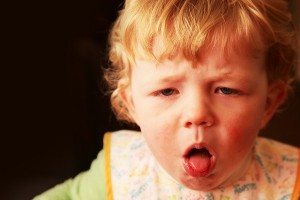Whooping Cough: Clearing the Air on Prevention
Pertussis (whooping cough), a highly contagious and serious respiratory tract infection, can spread when a person with the illness sneezes, coughs or simply shares breathing space with others for extended periods of time. While adults typically recover from whooping cough with few or no complications, infants are especially at risk for developing severe illness that could require hospital treatment.
According to the Centers for Disease Control and Prevention (CDC), whooping cough is on the rise. In 1980, there were only approximately 1,700 cases. However, in 2014, that number rose to nearly 33,000.
Whooping cough is on the rise. 1980 saw about 1,700 cases. That number jumped to nearly 33,000 in 2014.
The CDC also reports that about half of babies younger than one year of age who get whooping cough need treatment in the hospital. Of those hospitalized, 1 in 4 will develop a lung infection; and 1 in 100 babies will succumb to complications.
Rob Danoff, DO, an osteopathic family physician from Philadelphia, highlights the telltale signs of whooping cough and provides tips to preventing and spreading the illness.
Signs of Whooping Cough
According to Dr. Danoff, once you become infected with whooping cough, symptoms usually develop within five to 10 days but can take up to three weeks to appear. In adults, “symptoms are so mild at first that some people mistake the early signs of whooping cough—a runny nose or congestion, sneezing, and maybe a mild cough or fever—for the common cold,” says Dr. Danoff.
However, unlike the common cold, after one to two weeks, severe or prolonged coughing, marked at times by a high-pitched intake of breath that sounds like whoop, develops. “Babies who do get this severe cough may turn blue and vomit after coughing fits. However, some babies might not develop this cough or develop this sound, but rather develop more severe complications such as pneumonia, seizures and brain damage,” Dr. Danoff continues.
Complications can be life-threatening for infants less than 6 months old. If you think you or your child has whooping cough, Dr. Danoff recommends you make an appointment with your physician immediately or visit an urgent care center or a hospital’s emergency department if symptoms become more severe.
Preventive Tips for Parents and Caregivers
“Infants are especially susceptible to contracting this highly contagious disease,” says Dr. Danoff. The majority of babies who get whooping cough are infected by parents, siblings or other caregivers who are unaware that they even have the illness.
How can parents protect their children? “The first line of defense is to get your child vaccinated. Next, make sure that those in contact with the infant are also vaccinated,” says Dr. Danoff. The approach to vaccination is called “cocooning.” In other words, immunize all those who can be vaccinated in order to form a shelter of protection around infants who do not yet have vaccine-produced immunity. To protect you and your infant, Dr. Danoff recommends:
- If you are pregnant, it is important to receive a whooping cough booster vaccine (Tdap) during your third trimester, which begins at the 27th week of pregnancy; this may protect the infant during his or her first few months of life.
- Surround your baby with vaccinated family members and caregivers.
- Ensure your child gets the complete set of whooping cough vaccines at these ages: 2 months, 4 months, 6 months, 15 to 18 months, and 4 to 6 years.
- Schedule a booster shot (Tdap) at 11-12 years, the age when immunity from the pertussis (whooping cough) vaccine tends to wane.
- All adults need a one-time whooping cough booster vaccine called the Tdap as a substitute for one of their every-10-year booster shots of the Td (tetanus and diphtheria) vaccine.
Using a whole-person approach to care, Doctors of Osteopathic Medicine, or DOs, look beyond the symptoms of chronic pain to assess the impact of environmental and lifestyle factors on your health. They are trained to listen and partner with their patients, encouraging the body’s natural tendency toward self-healing.
